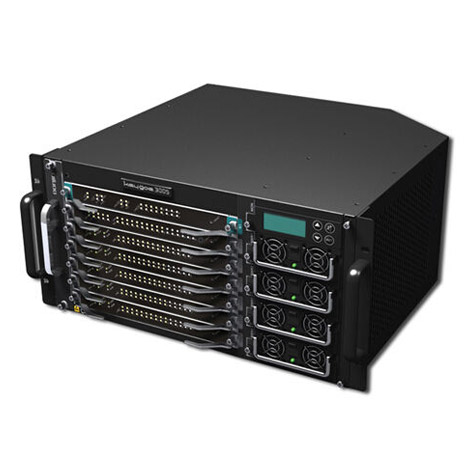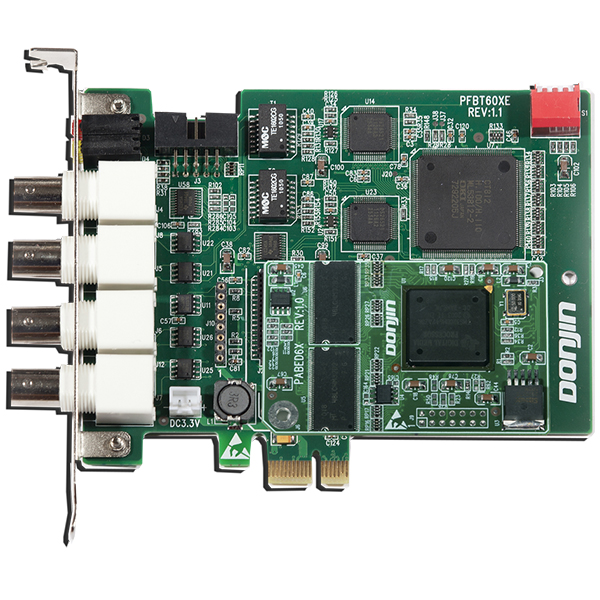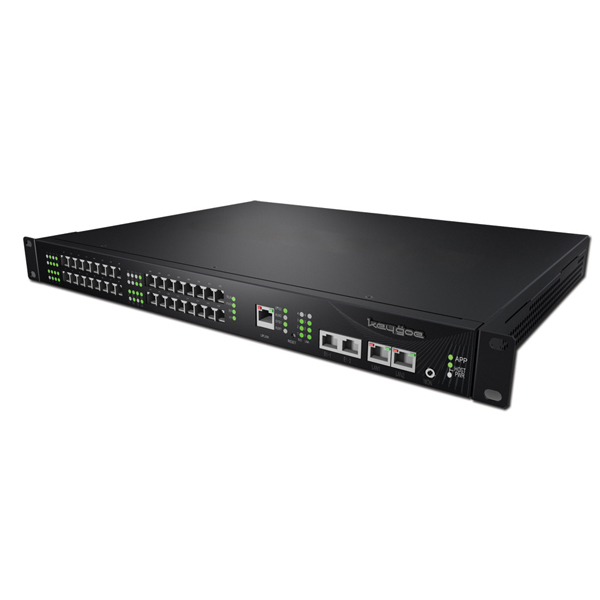Keygoe1001-PCS1UD2
DONJIN Keygoe1001-PCS1UD2 multi-media switch is a multimedia communication platform for 1 to 120 line applications in telecom value-added services, call center and enterprise communication for small and medium-sized enterprises. In a 1U chassis, it provides 2 E1 digital trunk interfaces, 30 analog interfaces, and extended 30 analog interfaces; thus, it can provide 120 voice resources, 120 VoIP resources, 30 fax resources, 64 conferences, 4 SS7 links (64 kbps), and 1 SS7 link (2 Mbps) in a high-impedance monitoring mode. This device has the features of nice integrity, comprehensiveness, simplicity, and flexibility, which is convenient for users to construct a highly efficient, easily deployed and maintained service system of high performance.
Integrity
l You can inset the CPU board in this standalone device, and then desploy integrated services, such as the IP-PBX, call center, multimedia conference system, digital recording system, fax server, and so on;
l You can select various CPU board types to meet various services. At present, "Intel? Core 2 Duo T7200" and " Intel? Atom N270" are supported.
Comprehensiveness
l A standalone switch possesses the functions of voice exchange, VoIP, voice playing, voice recording, faxing, conferencing, signaling processing, and so on.
High-Efficient management
l The analog trunk interface can detect the port voltage to improve the system management efficiecy;
l Simple usability (when the CPU board is built in);
l The software can be preloaded to the CPU board for fast installation and deployment;
l The built-in 4 network exchange interfaces are easily for extension;
l By a LAN port, the switch can connect to a host, which could be used as a redundancy for the built-in CPU board;
l The special CPU board switch ensures the service data integrity;
l Support to connect to the UPS with the serial port in case of power-off;
l The VGA and RS-232 are convenient to for external configuration or monitoring;
l Two USB 2.0 ports are convenient to connect to the SMS modem, dongle, and other USB devices.
Flexibility
l One-Stop ODM solution for customerization.
l 2 RJ48 E1 digital trunk interfaces;
l 32 RJ11 analog interfaces for 30 channels at most;
l 1 RJ48 Uplink interface to connect to one analog interface chassis;
l 2 RJ45 LAN interface (10/100M);
l 120 circuit switching channels at most;
l 120 voice resources at most;
l 30 fax resources at most;
l 120 IP resources at most Note;
l 64 conference resources at most (128 members for each one);
l 4 SS7 links of 64 kbps or 1 SS7 link of 2 Mbps at most (bidirectional high-impedance monitoring).
Note: In a standalone switch, when the VoIP resource number is over 30, you need configure the Keygoe1001 high-density VoIP daughter board "PABEIP120".
TDM interface and protocol
A) TDM interface
l Support the standard mode, high-impedance mode (the high-impedance adaptor need be connected externally);
l Conform to the G.703, and support the coaxial cable (75 Ω unbalanced), twisted-pair cable (120 Ω balanced);
l Conform to the frame structure of G.704 and multiframe alignment of G.706;
l The 2048 kbps PCM confirms to the G.732 and G.796;
l The alarm conforms to the G.775;
l Support power fault alarming;
l The jitter and wander conforms to the G.823;
l The analog interface supports the analog trunk, analog extension, analog high impedance, magneto telephone, 2-line EM, 4-line EM, and so on.
B) SS7
l Conform to the ITU-T signaling system No.7, including the Q.700-Q.716, Q.721-Q.766, and Q.771-Q.795;
l Maximum message processing ability for each link: 500 MSU/S;
l Support the MTP, TUP, ISUP, SCCP (transparency), and M3UA signaling function;
l Support the 64 kbps standard link and 2 Mbps high-speed link (monitoring);
l Support the 14/24-bit point codes;
l Support the traffic balancing between the links and link groups;
l Support the link switch and switch back in a link group;
l Support multiple OPCs (originating point codes) and DPCs(destination point codes);
l Support to dynamically add, delete, activate, recover, deactivate, normally restart, urgently restart signaling and to process signaling congestion;
l Support the SP and STP function.
C) ISDN PRI
l Conform to ITU-T Q.921 LAPD;
l Conform to ITU-T Q.931 ISDN PRI; European ISDN ETSI NET5;
l Support the network side and client side;
l Support the overlapping mode when receiving and sending called numbers.
IP interface and protocol
A) Network exchange interface
l TCP/IP 1000BASE-T port (RJ45)
SNMP
l Conform to the SNMPV1 and SNMPV2
B) RTP
l Conform to the RTP/RTCP (RFC3551/3552);
l Voice encoding/decoding format: G.711 μ law/ A law, G.723.1 (5.3/6.3 kbps self-adaptation), G.729A/B/AB;
l Voice activity detection/silence compression (G.723/G.729);
l Comfort noise;
l Voice packet sampling length/frame number can be configured (10–60 ms);
l Dynamic DTMF load of the RTP (RFC2833/4733);
l Jitter buffer: Support the static jitter mode and dynamic self-adaptation mode simultaneously;
l Analyze the network environment and make the statistics of packet loss;
l Support the NAT/firewall detection and transparency.
C) H.323
l Abide by the ITU-T H.323v2 (H.225v2/H.245v3);
l Support the coding standards of G.723, G.726, and G.729;
l Support the call parameters such as the fast start and H.245 tunneling;
l Call forwarding;
l Gatekeeper auto discovery and login (Support the number registration types of H.323 UID and E164);
l H.245 user input character and DTMF signal message (User Input Indication);
l Terminal registration management.
D) SIP
l Conform to the IETF SIPv2 (RFC3261);
l UDP/TCP transmission mode;
l MD5 (digest) identity test;
l REFER call forwarding (RFC3515);
l SIP message subscription/notice (RFC3265 SUBSCRIBE/NOTIFY);
l Proxy server register, user identification, and timely refreshing;
l SIP INFO message (RFC2976);
l Registrar; support the authentication of the service part;
l Support the NAT/firewall detection and transparency.
E) Audio protocols
l Voice encoding and decoding format: G.711 μlaw/A law, G.723.1, (5.3/6.3 kbps self-adaptation), and G.729A/B/AB;
l Voice activity detection/Silence compression (G.723/G.729);
l Comfort noise.
Media resource
A) Voice resource
l Voice code format: Support the A law/μ law PCM, AMI-ADPCM, G729, G723.1, and so on;
l Voice file format: Support the WAVE, PCM, ADPCM, VOX, MP3, and so on;
l Support the transfer between the A law and μ law;
l Support the voice playing of the memory and file server in the real time;
l Support the recording of the file server in the real time (dynamic memory);
l Support the DTMF, FSK, R2, and tone detection of self-defined envelope;
l Support the DTMF, FSK, R2, and tone generation of self-defined envelope;
l Support the mixed voice recording and playing;
l Support the echo canceling (128 ms);
l Support the AGC/ALS;
l Support the voice recording and playing in a full duplex mode;
l Support the VAD and CNG;
l Support the DPD and PVD.
B) Fax resource
l Support the V29/V27 with the rates of 14400/9600/7200/4800/2400bps; support the automatic down speeding;
l Support the T.30 and T.38;
l Support to receive/send fax in an ECM mode, selecting ECM/NON-ECM mode automatically;
l Support to input the .tiff file using the MR, MH, and MMR; support to send/receive files using the MH.
C) Conference
l One trunk channel can be configured to one conference resource.
l Voice services: IVR, telephone conferencing, color ring back tone (CRBT), background music, and telephone recording;
l Video services: multimedia CRBT, video telephone, video conference, video mail, 3G video, and video monitoring;
l Signaling services: virtual telephone exchange, signaling gateway, missed call service for fixed lines, integrated access gateway, media gateway, and mobile positioning;
l Integrated services: VoIP, unified messaging, Internet faxing, integrated QQ, and mobile payment;
l Call control services: pre-payment, post-payment, intelligent public telephone, and callback;
l Next-generation network: multimedia resource server;
l Call center: automatic voice playing, conference recording, IP agent, remote agent, video application, Web800, calling out, and automatic callback.
Type | Appearance | Function |
M2T |
| The analog trunk module, used for accessing the foreign exchange office (FXO) interface, with 2 trunk channels for each module |
M2U |
| The analog user module, used for accessing the foreign exchange subscriber (FXS), with 2 user trunk interfaces for each module, requiring the feed power and ring power. |
MTU |
| The analog trunk user module, used for connecting to the FXO and FXS, with each module processing one FXO interface channel and one FXS interface channel, requiring the feed power and ring power. It can be used as the emergency exit during power-off. |
M2R |
| The recording module, together with the analog interface board and digital phone recording board, is used to record calls on an analog phone. Each module can process 2 recording channels. |
MCS |
| Magneto module, used as a magneto phone, each module has 2 channels, requiring the feed power and ring power. |
MEM |
| The EM trunk control module is used to convert the telecom interfaces between devices. By the combinations from E lines and M lines, the forward signals and backward signals can be transmitted. It requires feed power. |
M2VOC |
| The EM 2-line voice module is used to convert the telecom interfaces between devices. By the combinations from E lines and M lines, the forward signals and backward signals can be transmitted. 2-line E/M trunk (for 4 lines, they are 2-line voice, E line, and M line). |
M4VOC |
| The EM 4-line voice module is used to convert the telecom interfaces between devices. By the combinations from E lines and M lines, the forward signals and backward signals can be transmitted. 4-line E/M trunk (for 6 lines, they are 2-line for receiving voice, 2-line for sending voice, E line, and M line). |

 “Financial Product”WeChat
“Financial Product”WeChat “Telecommunication Product”WeChat
“Telecommunication Product”WeChat









 Download
Download 